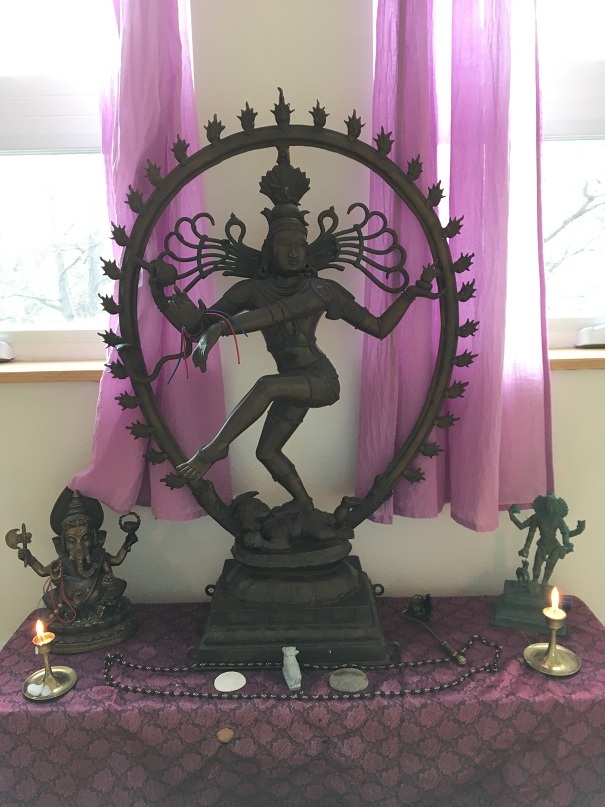Let’s take a moment to remember a fundamental teaching from the tradition: Consciousness in her freedom brings about everything in the universe (Pratyabijna Hridayam 1), and let’s focus on the second word of this aphorism: svatantrya. Usually translated as “freedom,” but remember the prefix “sva” means self, and “tantra” can mean loom, so another interpretation of this word is “self-looming.”
The tradition provides teachings on the various ways the highest Consciousness becomes concealed as we manifest as individuals, including the samskaras, all those latent impressions stored inside each of us that serve as activators of our thoughts and behavior. These samskaras can be negative habit patterns that lead us into suffering. And our practice of yoga, particularly meditation, attenuates those negative samskaras while at the same time laying down more positive samskaras. Our practice allows us greater access to the highest within us, which serves as a guide, if we listen.
As we loosen ourselves from the bonds of our samskaric patterning through our practice of yoga, we are better able to enact svatantrya, freedom. We are better able to consciously loom the fabric of our lives. Our journey of yoga yields the freedom to pause and make conscious what was previously unconscious. We gain what my teacher Paul Muller-Ortega calls “the ledge of freedom,” a resting place on our journey where we can pause and consciously choose our next step.
This is the pause that Arjuna takes at the beginning of the Bhagavad Gita, when he asks his charioteer Krishna to bring their chariot into the middle of the battlefield to consider the most prudent course of action. Instead of galloping automatically into battle, Arjuna pauses to ask questions of his highest Self, and he listens carefully to the answers. In this way he then mindfully chooses the highest course of action.
Continuing to enact our samskaric patterns without pause, without reference to the highest, demonstrates a lack of freedom. Often we think we are behaving freely when in fact we are slaves to our habit patterns. We are simply doing what we’ve always done without even considering our options. We have so many opportunities to exercise our freedom that we aren’t even aware of. Our meditation practice supports us in breaking these habitual patterns, allowing us instead to pause and understand we have another choice that may be more optimal.
We are seeing this play out in the COVID-19 pandemic in ways both small and large. Our habitual patterns of behavior have been brought to a halt. Our choices are limited. We are forced into being more mindful.
For example, on a small scale, we’ve had to pay attention to our hands: how we wash them and what we touch. This is an exercise in seeing how mindlessly we have done these things in the past.
We are seeing how our habitual ways of thinking, our general mindsets are being activated with regard to how think about the whole situation. Do we tend toward fear, blame, paranoia, kindness, compassion, depression? As our lives are stripped down, we have the opportunity to look at these patterns and out of our freedom choose how to be. Or we can unconsciously allow the old patterns to dominate and reiterate.
We yearn to go back to “normal,” which essentially means we want to enact our old behavioral patterns. That may not necessarily be bad, but we now have the opportunity, in this moment, to pause in the middle of our battlefield and evaluate whether “normal” is actually the highest way of being for everyone involved. Is there a better choice when we pause, listen to our higher self, and think about it? We have the freedom to choose to do something different.
For me, this ability to take this pause, listen, and envision different options has broadened as I’ve become a regular practitioner of meditation. Honestly it has surprised me to observe my ability to more readily watch an impulse arise, pause to consider whether I want to enact it, and make a conscious choice.
Perhaps freedom isn’t about our ability to do or enact anything without recourse. Ultimately this can lead to bondage on so many levels. Instead, I think of freedom as being free of the bonds of unconscious patterns, and acting out of a conscious consideration of what is the highest action in any given situation.
CONTEMPLATE AND PRACTICE
To what degree do you feel free? Consider your thoughts, feelings, and actions.
What inhibits you from feeling free?
What encourages a feeling of freedom?
Are there circumstances in which you limit your freedom of choice and/or expression?
Observe yourself as you negotiate the COVID-19 circumstances. What is it teaching you about freedom?

